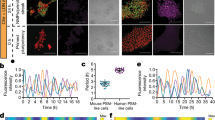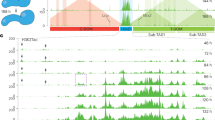Abstract
THE process of segmentation, in which the developing embryo is divided into repetitive structures along its antero–posterior (A–P) axis, as a means of organizing and coordinating the body plan is found in a wide range of organisms. In Drosophila, homoeotic genes are involved in all levels of segmental organization and in determining segment identity1. The roles of these genes in seg-mentation have been found mainly by mutational studies2,3, but also by in situ hybridization, which has shown their domains of expression. In contrast to Drosophila, however, embryonic expression of homoeobox-containing genes in vertebrate organisms has not been found to follow a segmental pattern4. Vertebrate segmentation can be clearly seen in the mesodermal somites, but repetitive morphological structures in the central nervous system (neuromeres)5–13 have only recently been shown to have develop-mental significance. Neuromeres in the hindbrain (rhombomeres) have been defined as segmental units by their pattern of nerve formation in the developing chick14 and by the alternating expression of Krox-20, a gene encoding a zinc-finger DNA-binding protein, in the 9.5-day-old mouse15. Here we report that a mouse homoeobox-containing gene, Hox-2.9, is expressed in a segment-specific manner in the developing mouse hindbrain. This expression is in a region which is flanked by the regions of expression of Krox-20, and is precisely contained within a single neuromere, rhombomere 4.
This is a preview of subscription content, access via your institution
Access options
Subscribe to this journal
Receive 51 print issues and online access
$199.00 per year
only $3.90 per issue
Buy this article
- Purchase on Springer Link
- Instant access to full article PDF
Prices may be subject to local taxes which are calculated during checkout
Similar content being viewed by others
References
Akam, M. Development 101, 1–22 (1987).
Lewis, E. B. Nature 276, 565–570 (1978).
Kaufman, T. C. in Time, Space and Pattern in Embryonic Development. 365–383 (Liss, New York, 1983).
Holland, D. W. D. & Hogan, B. L. M. Genes Dev. 2, 773–782 (1988).
Orr, H. J. Morph. 1, 311–372 (1887).
Streeter, G. L. Anat. Rec. 2, 111–115 (1908).
Neal, H. V. J. Morph. 31, 293–315 (1918).
Adelmann, H. B. J. comp. Neurol. 39, 19–171 (1925).
Berquist, H. & Kallen, B. J. comp. Neurol. 100, 627–660 (1954).
Vaage, S. Adv. Anat. Embryol. Cell Biol. 41, 1–88 (1969).
Tuckett, F., Lim, L. & Morriss-Kay, G. M. J. Embryol. exp. Morph. 87, 215–228 (1985).
Tuckett, F. & Morriss-Kay, G. M. J. Embryol. exp. Morph. 88, 231–249 (1985).
Sakai, Y. Anat. Rec. 218, 450–457 (1987).
Lumsden, A. & Keynes, R. Nature 337, 424–428 (1988).
Wilkinson, D. G., Bhatt, S., Chavier, P., Bravo, R. & Charnay, P. Nature 337, 461–464 (1989).
Graham, A., Papalopulu, N. & Krumlauf, R. Cell 57, 367–378 (1989).
Do, M-S. & Lonai, P. Genomics 3, 195–200 (1988).
Deol, M. S. J. Embryol. exp. Morph. 12, 475–490 (1964).
Hertwig, P. Z. Indukt. Abstammungs-Vererbungsl. 80, 220–246 (1942).
Laughon, A. & Scott, M. P. Nature 310, 25–31 (1984).
Miller, J., McLachlan, A. D. & Klug, A. EMBO J. 4, 1609–1614 (1985).
Chavrier, P. et al. EMBO J. 7, 29–35 (1988).
Ingham, P. Nature 335, 25–34 (1988).
Mlodzik, M., Fjose, A. & Gehring, W. J. EMBO J. 7, 2569–2578 (1988).
Duboule, D. & Dolle, P. EMBO J. 8, 1497–1505 (1989).
Diederich, R. J., Merrill, V. K. L., Pultz, M. A. & Kaufmann, T. C. Genes Dev. 3, 399–414 (1989).
Mahaffey, J. W., Diederich, R. J. & Kaufmann, T. C. Development 105, 167–174 (1989).
Hogan, B., Holland, P. & Schofield, P. Trends Genet. 1, 67–74 (1985).
Gaunt, S. J. Development 101, 51–60 (1987).
Gaunt, S. J., Miller, J. R., Powell, D. J. & Duboule, D. Nature 324, 662–664 (1986).
Davidson, D., Graham, E., Sime, C. & Hill, R. Development 104, 305–316 (1988).
Author information
Authors and Affiliations
Rights and permissions
About this article
Cite this article
Murphy, P., Davidson, D. & Hill, R. Segment-specific expression of a homoeobox-containing gene in the mouse hindbrain. Nature 341, 156–159 (1989). https://doi.org/10.1038/341156a0
Received:
Accepted:
Issue Date:
DOI: https://doi.org/10.1038/341156a0
This article is cited by
-
Hox genes, evo-devo, and the case of the ftz gene
Chromosoma (2016)
-
The gene regulatory networks underlying formation of the auditory hindbrain
Cellular and Molecular Life Sciences (2015)
-
The emerging framework of mammalian auditory hindbrain development
Cell and Tissue Research (2015)
-
Targeted germ line disruptions reveal general and species-specific roles for paralog group 1 hox genes in zebrafish
BMC Developmental Biology (2014)
-
Chick Lrrn2, a novel downstream effector of Hoxb1 and Shh, functions in the selective targeting of rhombomere 4 motor neurons
Neural Development (2009)
Comments
By submitting a comment you agree to abide by our Terms and Community Guidelines. If you find something abusive or that does not comply with our terms or guidelines please flag it as inappropriate.



